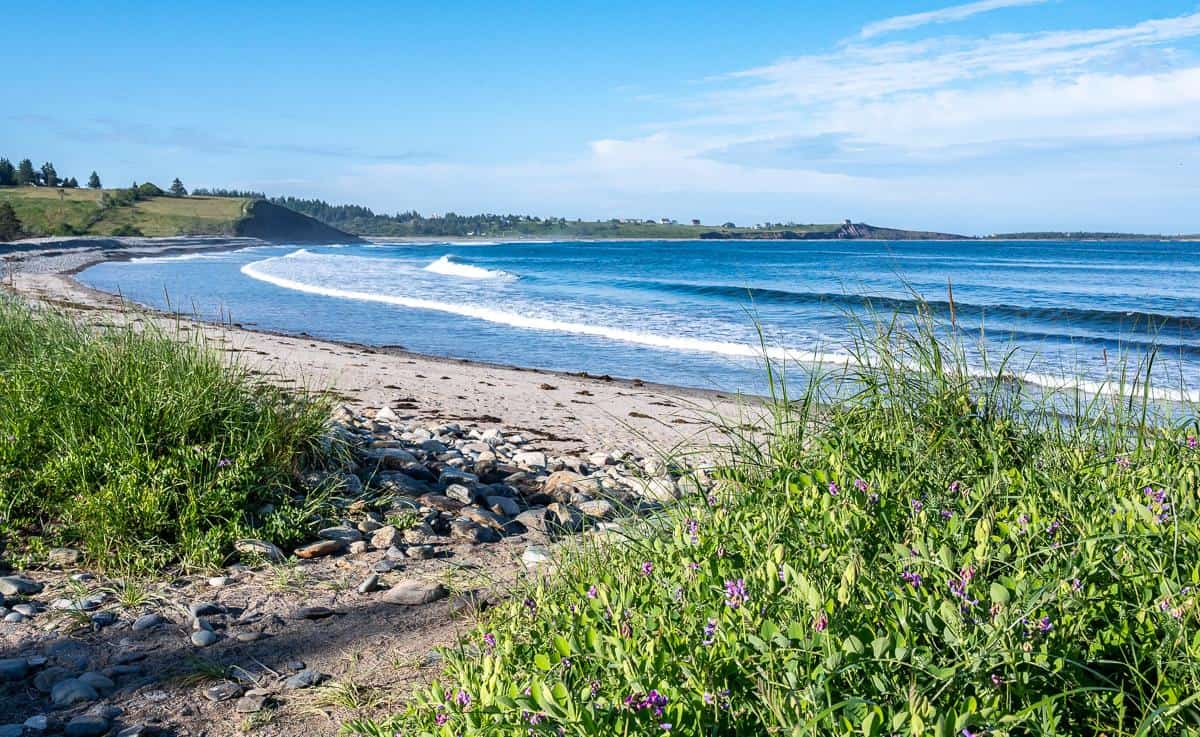7 Best Circular Walks On The Pembrokeshire Coast Path
12 min read
Table of Contents
The Pembrokeshire Coast Path meanders for 186 miles passing towering cliffs and golden beaches. Here is our pick of the best day walks exploring the Pembrokeshire Coast.
The Pembrokeshire Coast Path is a spectacular 186 mile National Trail winding its way along the far southwest coast of Wales. During its journey, it passes towering cliffs and golden beaches, cute villages with tiny harbours and emerald-green lagoons.
It is undoubtedly some of the finest scenery in the UK.
It takes 10 to 15 days to walk the entire route from Amroth in the south to St Dogmaels in the north. But if you don’t have that sort of time, it’s entirely possible to complete some of the best sections and see many of the highlights of the Pembrokeshire Coast on shorter day walks.
We have picked our seven favourite circular walks along the Pembrokeshire Coast Path. All use the National Path at some point, but to create interesting circular walks, they also head inland via craggy tops, stately homes, or pretty towns.
Some are only a couple of hours on generally flat ground, while others are more challenging – heading over headlands and up to rocky summits. Each is a little different, although all pass through magnificent scenery along lovely trails.
It goes without saying that – like almost all of our hikes – most of these Pembrokeshire walks involve a pitstop in an atmospheric pub or a well-positioned cafe.
We have included detailed maps for each hike, the best things to see and do along the trail, plus where to stay. Hopefully, everything you will need to have a great day out exploring the Pembrokeshire Coast.
READ NEXT / OUR GUIDE TO THE GOWER PENINSULA
// Booking your trip via the links on this page (or on our book page) will earn us a small commission, at no extra cost to you. Thanks for your support – Paul & Mark.

1 – STACKPOLE AND BARAFUNDLE CIRCULAR WALK
Difficulty – Easy to Medium | Distance – 10 kilometres (6.2 miles) | Time – 3 hours 15 minutes | Start – Bosherston National Trust Car Park | Directions – Clockwise on our Stackpole & Barafundle Walk Map
It’s not always easy to find a great circular walk along the coast but this is a cracker. The coastal section roams over magnificent headlands with views stretching down past rugged cliffs to the surging ocean below.
Along the way it visits a tiny harbour, a dramatic deep blue pool, and magnificent Barafundle beach. Backed by dunes with cliffs rising on either side, it is one of the finest in the UK.
The vertiginous cliffs are dramatic and scary at the same time. Look carefully and you may see intrepid adventurers hanging from ropes attempting climbs like The Widowmaker, Heart of Darkness or Blowin in the Wind.
Inland, the trail meanders through the Stackpole Estate and its famous Lily Ponds. In June and July, beautiful white flowers float on the man-made lake and if you are extremely lucky you may see an otter darting in and out of the banks.


2 – MARLOES PENINSULA CIRCULAR WALK
Difficulty – Medium | Distance – 10.75 kilometres (6.7 miles) | Time – 3 hours 30 minutes | Start – Marloes Sands National Trust Car Park | Directions – Anti-clockwise on our Marloes Peninsula Walk Map
There are three great reasons to attempt this walk. Firstly, the scenery on the southern side of the Marloes Peninsula is some of the finest on the Pembrokeshire Coastal Path. Streaky grey slate forces its way through sandy beaches and swelling seas, forming sharp triangles of rock jutting through the golden sand and blue-green waters.
Secondly, the lovely narrow path clings to the cliff top as it meanders along the edge of the headland and cuts through swathes of yellow gorse, swaying bracken, and seasonal flowers. In spring, purple foxgloves line the route before late summer sees the heather bloom.
Thirdly, although the greatest proliferation of birdlife is found on Skomer Island (one of our favourite places to visit in Pembrokeshire), this hike heads to Wooltack Point, on the headland opposite. From May to July, you may see puffins, guillemots, and razorbills fishing for food. If you are really lucky you may spy thousands of Manx Shearwaters gathering on the water in the early evening. Seals can be seen all year round but come ashore to give birth in October and periodically porpoises can be spotted in the waves. Binoculars might be a good idea.


Begin the walk at the National Trust Car Park at Marloes Sands and head anti-clockwise following the route on the map linked below. The walk takes a little over three hours, involves a couple of short climbs, but is relatively easy. Grab lunch at the excellent National Trust Runwayskiln café (public toilets next door) to finish off a great day out.
OUR MARLOES PENINSULA WALK TIP
Boats to Skomer Island leave from Martin’s Haven harbour, which you pass on this walk. If you are interested in birdwatching, a visit here is not to be missed, but you will need to book in advance.


3 – SOLVA AND THE GRIBBIN HEADLAND CIRCULAR WALK
Difficulty – Easy to Medium | Distance – 4 kilometres (2.5 miles) | Time – 1 hour 30 minutes | Start – Lower Solva Car Park | Directions – Anti-clockwise on our Solva & Gribbin Map
This short but glorious circular walk is perfect if you want a quick taster of all that is great about the Pembrokeshire Coast National Park.
The walk begins in Lower Solva, a colourful village at the end of a deep cut inlet. In 1900, 30 ships and 9 warehouses made this a buzzing hub. But today it has an altogether more relaxed feel and at high tide its brightly painted houses shimmer as boats bob cheerily in the harbour.
The path begins by heading up to the Gribbin peninsula, providing fine views of the town, then drops to a tiny cove and rises again to head along the coast. For the next kilometre you pass dramatic rock formations and secret beaches before heading inland.


After crossing some fields and passing an ancient burial chamber, the trail heads into a lovely-wooded glen that drops to a bridge over a babbling brook. On a warm day, shade from swaying trees brings relaxing relief before a short steep climb back over the Gribbin headland and into Lower Solva.
End the walk with a snack at MamGu which does a healthy trade in Welsh Cakes. It’s also great for vegetarians.
OUR SOLVA & GRIBBIN HEAD WALK TIP
Please note that if you are using Ordnance Survey Maps, the path markings are wrong around St. Elvis Farm. The owners have redirected the route, so please refer to our map below. Also, be aware that although it is only 2.5 miles long, there are three steep 60 to 70 metre climbs up and over the headlands.


4 – TREGINNIS CIRCULAR WALK
Difficulty – Medium | Distance – 14.25 kilometres (8.9 miles) | Time – 4 hours 30 minutes | Start – St Justinian’s, Porthclais or Merrivale Car Park | Directions – Anti-clockwise on our Treginnis Peninsula Map
This is a lovely circular walk around the Treginnis headland that covers almost the entire southern half of the St Davids head peninsula. The coastal cliffs are not as high and the beaches perhaps not quite as pretty as other walks, but it is the diversity that makes it special.
In just over 4 hours you pass St Justinian’s boathouses; numerous coves tucked into headlands; the giant gash of Porthlysgi Bay and the charming harbour of Porthclais. Keeping you company on your journey are the rushing gurgling waters of Ramsey Sound which can reach up to 6 knots on spring tides.
After passing the rocky coast around St Nons, the trail then heads inland to the town of St Davids. Take a detour to the magnificent cathedral where wealth poured in after Pope Calixtus II declared two pilgrimages to St Davids is equal to one to Rome, and three to Jerusalem.


The only downside is the 3 kilometres of country lane walking between St Davids and St Justinians. While the craggy hillock strewn fields are attractive, at times you need to stand on the verge to allow the traffic to pass.
There’s a National Trust café and toilets and Porthclais and plenty of facilities in the city of St. Davids, which makes an excellent base for exploring the area.
OUR TREGENNIS PENINSULA WALK TIP
You can start the walk from St Justinians, Porthclais (National Trust) or Merrivale (St Davids) car parks. If you don’t fancy the hike along the roads from St Davids to St. Justinians, take the 403 Celtic Coaster bus. See links for timetables at the end of the post.


5 – WHITESANDS & CARN LLIDI CIRCULAR WALK
Difficulty – Medium | Distance – 6.75 kilometres (4.2 miles) | Time – 2 hours 15 minutes | Start – Whitesands Car Park | Directions – Clockwise on our Whitesands and Carn Llidi Walk Map
This circular walk is for those that like their hikes wild and rugged. There are no cute harbours or pretty villages, just miles and miles of gorse, rock, and heather. It’s a bleak and lonely place where the crowds disappear and the paths seem to stretch on forever.
Along the way there are brief reminders of life: the remains of a Celtic Chapel; a long-lost ancient fort; ruined burial chambers and the dolmen of Coetan Arthur. But the highlight is summiting Carn Llidi. Its dramatic buttressed craggy features and far-reaching views belie its 181-metre height.
The walk begins and ends at Whitesands Beach, a sweeping stretch of powdery white sands. End the day with a refreshing swim, watch the surfers rule the waves or simply chill out in a deckchair.


OUR WHITESANDS AND CARN LLIDI WALK TIP
Whitesands Beach is great for families. There’s a café, toilets and on summer days you can rent deckchairs, windbreaks, surfboards, and wetsuits. Parking is £5 for the day (in cash) and does get busy in peak season, although the attendant often opens overflow parking in the nearby fields.


6 – PORTHGAIN & ABEREIDDY WALK
Difficulty – Easy to Medium | Distance – 6.5 kilometres (4 miles) | Time – 2 hours | Start – Porthgain Village (Free) | Directions – Anti-clockwise on our Porthgain Abereiddy Walk Map
In our opinion, this is the most interesting short walk along the Pembrokeshire Coastal Path. It begins in the intriguing village of Porthgain which was a prosperous industrial harbour in the early 1900s.
Slate quarried a few miles south was carried by tramway to the village before being shipped from its tiny harbour. In later years slate was replaced with brickmaking and a gigantic hopper was built into the cliff above the village. Today the remnants of its industrial past stand as stark reminders of a bygone age.
From Porthgain the trail climbs up some steps and follows the coastal path south, passing magnificent scenery dotted with old quarries, remains of the tramway and ruined slate buildings. After half an hour you reach the secret beach of Traeth Llyfn, our favourite on the Pembrokeshire Coast.
Another 15 minutes further brings you to the Blue Lagoon. Originally a slate quarry it closed in 1910. Spotting a unique opportunity, local fisherman blasted a narrow channel between the quarry and the sea, creating an artificial harbour in the old pit. Today, the Blue Lagoon is great for a quick dip or some rather thrilling leaping from the slate buildings that line its edge.


After about an hour, the path arrives at Abereiddy, where you will find another beach, car park (£4 for the day) and toilets. You can head back inland across the fields (see map below), but for once it’s probably better to return along the coast.
Whichever you choose, end the hike with a drink at the Sloop Inn in Porthgain. Established in 1743, the pub is packed with memorabilia harking back to the village’s industrial and fishing past.
OUR ABEREIDDY & PORTHGAIN WALK TIP
While in the area, we highly recommend joining a coasteering tour in the Blue Lagoon. Coasteering involves scrambling along rocky coastlines and playing in the surging surf. It was invented in Pembrokeshire and the Blue Lagoon is a great place to have a go.
7 – STRUMBLE HEAD CIRCULAR WALK
Difficulty – Medium to Challenging | Distance – 10 kilometres (6.2 miles) | Time – 3 hours 15 minutes | Start – Garn Fawr Car Park | Directions – Clockwise on our Strumble Head Walk Map
This is the hardest of our circular walks on the Pembrokeshire Coast Path. Not so much for the distance, as much as the amount of ascent and descent. It requires some puff, but it’s well worth the effort. The hike offers tremendous views around undulating coastal cliffs and two great points of interest.
At the far end of the peninsula, standing imposingly on St. Michaels Island is the Strumble Head Lighthouse. The 17-metre white tower was built in 1908 to protect sea traffic between Ireland and Fishguard and still contains the original lantern. Electrified in 1965 and automated in 1980 it offers an excellent focal point for photographers.
The walk also climbs to the summit of Garn Fawr, at 213 metres it is the highest point on this stretch of coast. At its summit is an iron age fort constructed more than 2,500 years ago. It makes excellent use of the hill’s natural lines, linking the rocky outcrops with stone walls. The views from here over a patchwork of green fields and disappearing headlands is remarkable.


INSTRUCTIONS FOR USING OUR PEMBROKESHIRE COASTAL WALKS MAPS
All our Pembrokeshire Coastal walks are included on the below map, however, each of the specific routes are shown on the maps linked under each walk.
How to use this map / Click on the top left of the map to display the list of locations, then click on the locations to display further information. Click on the top right corner of the map to open a larger version in a new tab or the star to save to your Google Maps.
HOW TO GET AROUND THE PEMBROKESHIRE COAST
BY CAR
The best way to get to these circular Pembrokeshire Coast walks is to drive. It’s a maximum of just over a 1-hour drive between any of them and it’s the perfect inclusion on a Wales road trip. The most convenient car parks are marked on the maps. All are either free, have an attendant that takes cash or card or machines that take credit card.
The National Trust owns a lot of the property along the Pembrokeshire Coast. Being a member allows you to park in their car parks for free (saving you roughly £4 per park). If you have ever thought of joining, then doing so before visiting Pembrokeshire makes a lot of sense.
If you are looking to hire a car for your Pembrokeshire trip, we recommend rentalcars.com who compare prices across all the major car rental companies.
CHECK PRICES — RENTALCARS.COM
BY BUS
There is a series of shuttle buses that run up and down different down sections of the Pembrokeshire Coast. The buses run 7 days a week from May to September and make the entire 186 miles of the Pembrokeshire Coastal Path accessible.
Here is the full list of coastal buses.
The 387 Coastal Cruiser connects the town of Pembroke with Stackpole and Bosherston (covering walk 1). The 400 Puffin Shuttle runs from St Davids to Marloes via Lower Solva (covering walks 2 & 3). The 403 Celtic Coaster connects the various places of interest around St. Davids Head peninsula (covering walks 4 & 5). The 404 Strumble Shuttle runs from St. Davids to Newport via Porthgain and Strumble Head (covering walks 6 & 7).


WHERE TO STAY ON PEMBROKESHIRE COAST
If you are planning on doing several of these day walks, and you intend on using public transport, St Davids is a great place to base yourself. The bus routes in and out of town connect to many of the walks and there are plenty of handy facilities to equip yourself for a day out exploring the best of the Pembrokeshire Coast.
If you are driving then you have a lot more freedom. Anywhere near the coast between Tenby to Fishguard will have you located no more than a 70-minute drive from each of the walks. Ideally, split your stay in half and spend a few days in the Tenby / Stackpole area and a few days around St Davids.
You can find our favourite places to stay in our guide to the best hotels, huts & B&B’s in Pembrokeshire.

LOVE THIS GUIDE?
If you found this guide useful, buying us a coffee will help fuel our next adventure.








